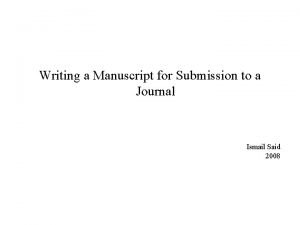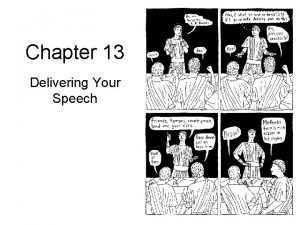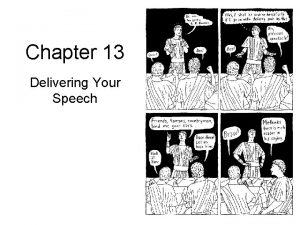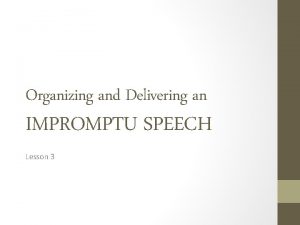Organizing and Delivering a MANUSCRIPT SPEECH Lesson 1














- Slides: 14

Organizing and Delivering a MANUSCRIPT SPEECH Lesson 1

When speaking from a manuscript, you write and deliver a speech word for word. The question is, for whom is the manuscript method most advantageous? 1. Public figures. Since public figures are always constrained by a hectic schedule, they need ghost writers. Consequently, they would have to read the text of the speech as it is. The President’s State of the Nation Address (SONA) is a concrete example of this situation.

2. Media personalities. Speakers on radio and television always battle with time limits. For example, a televised panel discussion about a social issue may require radio and TV anchors to critically choose and refine the words of their speech in advance.

3. Spokespersons for government and private organizations. This public speaking role requires a great deal of contemplation and preparation. For example, we have speeches of different country’s spokespersons in an international seminar on climate change.

Potential Problems with the Manuscript Method 1. Since this type of speech follows a word-for-word method, you might be tempted to skip practicing the speech. 2. In relation to the previous point, if you fail to practice your speech and decide to read it during the time of delivery itself, you might be glued to the speech all throughout. You may overlook making eye contact with

your audience. Note that glancing at the audience only at the end of a sentence is not sufficient to establish and maintain rapport during the speech. 3. Lastly, because everything is planned based on the time allotted, you will surely want to cover everything in your speech before you run out of time. This might affect your connection with the

audience, as there is a tendency to ignore the audience and neglect responding to their feedback when busy with the speech. Pay attention and make sure to check and adjust if the audience displays anxiety, impatience, or boredom.

Strategies in Organizing and Delivering the Manuscript Speech 1. Practice! Practice delivering the speech several times. Mark the text. Even if it’s a manuscript, know the speech by heart. Only if you do these can you keep frequent eye contact with the audience.

2. Adapt! Even if you have a manuscript, feel free to modify the text when the situation demands it. If you observe that your audience is bored, you may use shorter yet more vigorous words. If your audience is impatient, add words of strong motivational power. If your audience is anxious, share personal anecdotes to lighten the mood.

Tips in Using the Manuscript Method 1. Prepare! Keep your text easy to use by neatly composing it in triple space. 2. Mark! Own your manuscript by highlighting key words and phrases. This way you will be guided during the speech delivery.

3. Practice! You can make a lot of notes on the draft of your manuscript during the first few rehearsals, but make sure to reprint your script, especially if you make too many changes. 4. Practice some more! Read the text over and over orally. This will help you avoid

mispronounced words, faulty starts, and wrong pauses. As you practice, vary the volume, rate, and pitch of your voice during appropriate points in the speech. 5. Concentrate! Concentrate on keeping eye contact, but do not stare at only one section of the audience. It is best if you

familiarize yourself with the most important parts of your speech. If you do this, you will be more confident in looking at your audience during the key points of the speech. 6. Act it out! Use a lectern or a podium when practicing the speech. If you can find one before the actual speech

delivery, practice using it so that you will be used to laying your notes flat on the podium and looking at them once in a while.
 Organizing and delivering an entertainment speech
Organizing and delivering an entertainment speech Entertainment speech delivery
Entertainment speech delivery What is a manuscript speech?
What is a manuscript speech? Manuscript speech
Manuscript speech Manuscript speech
Manuscript speech Organizing and outlining your speech
Organizing and outlining your speech Outlining and organizing the speech contents
Outlining and organizing the speech contents Organizing a speech
Organizing a speech Strategic organization speech
Strategic organization speech Designing and delivering oral and online presentation
Designing and delivering oral and online presentation Building and delivering customer value and satisfaction
Building and delivering customer value and satisfaction Organizing the elements lesson quiz
Organizing the elements lesson quiz Medical manuscript writing
Medical manuscript writing Ias manuscript central
Ias manuscript central Manuscript format short story
Manuscript format short story


























